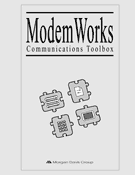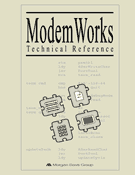ModemWorks
Dan Gookin, famous computer book writer, jokingly called me Modem Davis due to my deep interest in telecommunications. To program modems effectively and make ProLine go, I had to devise a communications toolbox. So ModemWorks was developed.
If you knew 6502 or 65816 assembly language, and had a lot of time on your hands, you could write your own serial port and modem drivers. But most Apple II users wanted a fast and easy solution they could use from BASIC. ModemWorks let them easily turn ordinary BASIC applications into online tools, and took care of all those messy details that made writing modem-based programs a hassle.

In 1984, the Hayes Smartmodem 1200 let you download text faster than you could read it.
Since users had different types of computers and modems, ModemWorks needed easily interchangeable parts that integrated efficiently. This inspired the creation of my Object Module Manager (see below). With a well-documented modular architecture, developers could now easily add their own modules. The ModemWorks Technical Reference (MWTR) guides the advanced programmer through the steps needed to develop custom modules.
According to our sales database (which I wrote in FoxBASE), we sold more copies of ModemWorks than any other product. The credit goes to a headstart from Living Legends Software, an early shareware co-op experiment that I conducted with Jerry Hewett in the early 80s.
Prophetic excerpt from page 6 of the Technical Reference:
Rare disk label. Early copies of ModemWorks were distributed as shareware.
“Let us not believe that even with this new architecture that we will enjoy the cutting edge forever. We may not be communicating using modems in the next eight years. Undoubtedly, new technology will make modems obsolete. Perhaps we’ll connect via high-speed links over direct connections handled for us by the phone (or cable TV?) company. No more Hayes-style AT commands. No more voice-grade lines. We’ll all just network like so many computerized television sets.”
That was written in 1992 long before ISDN, DSL, and high-speed cable were commonplace for Internet access.
![]() ModemWorks-3.1.img 800K ProDOS disk
ModemWorks-3.1.img 800K ProDOS disk
![]() ModemWorks-3.1.pdf 319K Acrobat file, 72 pages
ModemWorks-3.1.pdf 319K Acrobat file, 72 pages
![]() MWTR-3.1.pdf 135K Acrobat file, 40 pages
MWTR-3.1.pdf 135K Acrobat file, 40 pages
Add a Comment


